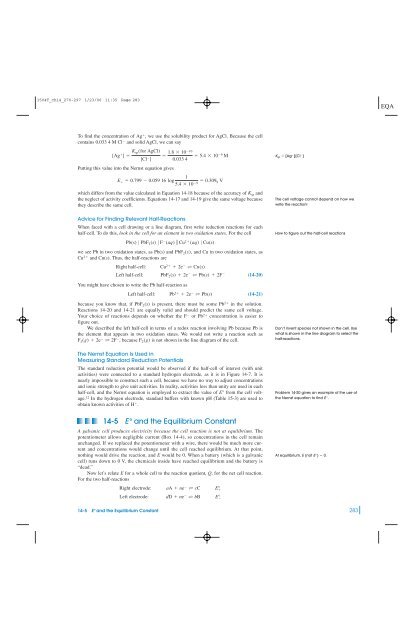Fundamentals of Electrochemistry - W.H. Freeman
Fundamentals of Electrochemistry - W.H. Freeman
Fundamentals of Electrochemistry - W.H. Freeman
Create successful ePaper yourself
Turn your PDF publications into a flip-book with our unique Google optimized e-Paper software.
1504T_ch14_270-297 1/23/06 11:35 Page 283<br />
To find the concentration <strong>of</strong> Ag , we use the solubility product for AgCl. Because the cell<br />
contains 0.033 4 M Cl and solid AgCl, we can say<br />
Putting this value into the Nernst equation gives<br />
which differs from the value calculated in Equation 14-18 because <strong>of</strong> the accuracy <strong>of</strong> and<br />
the neglect <strong>of</strong> activity coefficients. Equations 14-17 and 14-19 give the same voltage because<br />
they describe the same cell.<br />
Advice for Finding Relevant Half-Reactions<br />
When faced with a cell drawing or a line diagram, first write reduction reactions for each<br />
half-cell. To do this, look in the cell for an element in two oxidation states. For the cell<br />
we see Pb in two oxidation states, as Pb(s) and PbF 2 (s), and Cu in two oxidation states, as<br />
and Cu(s). Thus, the half-reactions are<br />
Cu 2<br />
[Ag ] K sp(for AgCl)<br />
[Cl ]<br />
Right half-cell:<br />
Left half-cell:<br />
<br />
1.8 1010<br />
0.033 4<br />
Cu 2 2e T Cu(s)<br />
5.4 10 9 M<br />
1<br />
E 0.799 0.059 16 log<br />
5.4 10 0.309 9 9 V<br />
Pb(s) 0 PbF 2 (s) 0 F (aq) Cu 2 (aq) 0 Cu(s)<br />
PbF 2 (s) 2e T Pb(s) 2F <br />
K sp<br />
(14-20)<br />
K sp [Ag ] [CI ]<br />
The cell voltage cannot depend on how we<br />
write the reaction!<br />
How to figure out the half-cell reactions<br />
You might have chosen to write the Pb half-reaction as<br />
Left half-cell:<br />
Pb 2 2e T Pb(s)<br />
(14-21)<br />
because you know that, if PbF is present, there must be some Pb 2<br />
2 (s)<br />
in the solution.<br />
Reactions 14-20 and 14-21 are equally valid and should predict the same cell voltage.<br />
Your choice <strong>of</strong> reactions depends on whether the F or Pb 2 concentration is easier to<br />
figure out.<br />
We described the left half-cell in terms <strong>of</strong> a redox reaction involving Pb because Pb is<br />
the element that appears in two oxidation states. We would not write a reaction such as<br />
F 2 (g) 2e T 2F , because F 2 (g) is not shown in the line diagram <strong>of</strong> the cell.<br />
The Nernst Equation Is Used in<br />
Measuring Standard Reduction Potentials<br />
The standard reduction potential would be observed if the half-cell <strong>of</strong> interest (with unit<br />
activities) were connected to a standard hydrogen electrode, as it is in Figure 14-7. It is<br />
nearly impossible to construct such a cell, because we have no way to adjust concentrations<br />
and ionic strength to give unit activities. In reality, activities less than unity are used in each<br />
half-cell, and the Nernst equation is employed to extract the value <strong>of</strong> E° from the cell voltage.<br />
12 In the hydrogen electrode, standard buffers with known pH (Table 15-3) are used to<br />
obtain known activities <strong>of</strong> H .<br />
Don’t invent species not shown in the cell. Use<br />
what is shown in the line diagram to select the<br />
half-reactions.<br />
Problem 14-20 gives an example <strong>of</strong> the use <strong>of</strong><br />
the Nernst equation to find E°.<br />
14-5 E and the Equilibrium Constant<br />
A galvanic cell produces electricity because the cell reaction is not at equilibrium. The<br />
potentiometer allows negligible current (Box 14-4), so concentrations in the cell remain<br />
unchanged. If we replaced the potentiometer with a wire, there would be much more current<br />
and concentrations would change until the cell reached equilibrium. At that point,<br />
nothing would drive the reaction, and E would be 0. When a battery (which is a galvanic<br />
cell) runs down to 0 V, the chemicals inside have reached equilibrium and the battery is<br />
“dead.”<br />
Now let’s relate E for a whole cell to the reaction quotient, Q, for the net cell reaction.<br />
For the two half-reactions<br />
Right electrode:<br />
Left electrode:<br />
aA ne T cC<br />
dD ne T bB<br />
E° <br />
E° <br />
At equilibrium, E (not E°) 0.<br />
14-5 E° and the Equilibrium Constant 283

















